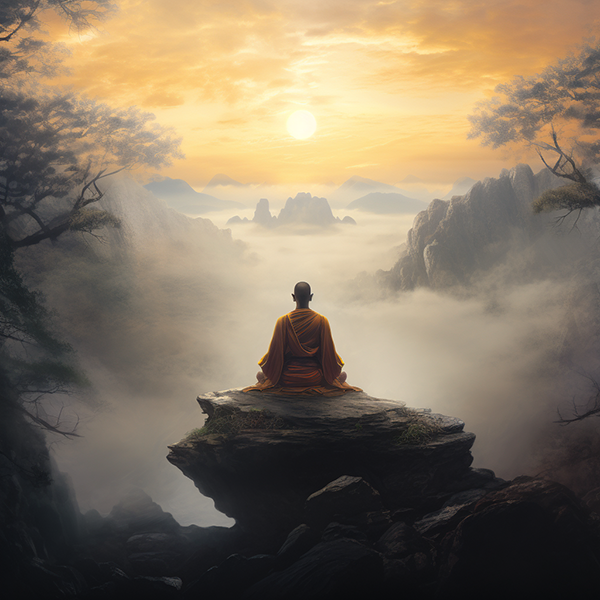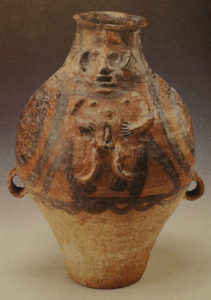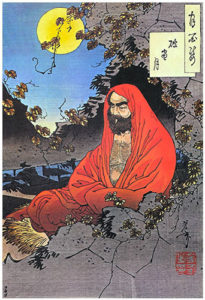
To truly understand something, there is value in seeking out its root, or origin, to see where it came from, and then tracing its development to understand why it takes the form that it does now. Qigong practice is so ancient, that its first origins are lost in the mists of time. It arose from a desire to understand and harness the vital living energy known as qi, that flows through all living things. This concept of vital energy was common to many ancient cultures, with each developing their understanding and application of this concept in different ways. The Chinese in particular developed a very rich and detailed understanding of the flow of living energy and how to work with it, which each of us can benefit from today.
Earliest Origins
Some of the earliest qigong practices are said to have developed from the shamanistic dances of the common people in the Neolithic era. These Chinese villagers would work hard all day in the fields and rice paddies. At the end of each day they would be cold, wet, and tired. Not surprisingly, this led to sickness and aches and pains of various sorts. They discovered that if when they came home they danced vigorously, copying the movements of the animals that they observed during the day, instead of just resting, they did not get sick as much. This became a tradition for them, to dance at the end of each day to ward of illness and disease. As time progressed their understanding of this process grew more refined. They started to notice that certain movements were particularly good for helping with certain kinds of problems, and little by little their knowledge, and theory of the underlying mechanisms developed and became systematized. They started to recognize the way that moving and thinking in different ways directed the life force energy within them.
The first known archeological evidence of this type of qigong practice is a piece of Neolithic pottery estimated to be between 5000 and 8000 years old, which shows a figure of a person in a qigong like posture. From these ancient origins this understanding of life force energy or ‘qi’ permeated into every aspect of Chinese culture and underpins much of their philosophy, medicine, martial arts, and even religion.
Famous Figures in Qigong History
The first written reference to qigong is found within the Huangdi Neijing, or Yellow Emperor’s Classic of Internal Medicine around 2600 BCE. This legendary figure is though to be the founder of Chinese medicine, and the Yellow Emperor’s classic is its founding text, so ever since that time qigong has had a strong association with medicine, and other famous physicians such Hua Tuo (140-208 CE) who is credited with creating a five animal play system of qigong, have played an important role in qigong’s ongoing development.
The most influential figures in each of the main branches of Chinese philosophy have also all played their part in qigong’s development. The writings of Confucius (551-479 BCE), Mencius (385-302 BCE), and Lao Tzu (ca. 400 BCE) all make reference to different aspects of qigong practice.
One particularly interesting case is that of Bodhidharma (ca. 500 CE) the Buddhist monk known in China as Damo, who is credited both with introducing Chan (commonly known as Zen) Buddhism to China, and also with introducing the Buddhist monks at the Shaolin temple to sets of moving qigong exercises to keep them healthy and focused while meditating. These exercises then went on to become very influential within the Chinese martial arts.
Another famous martial artist in Qigong history was the General Yue Fei (1103-1142 CE), reputed to have never lost a battle in his long military career, General Yue Fei also developed the Ba Duan Jin, which he used to keep his soldiers healthy and ready for combat. The Ba Duan Jin is still one of the most famous sets of qigong exercises today – although it is hard to say how closely what is practiced today relates to the original exercises of Yue Fei, as there are very many different versions of this set, and some say that originally there were 12 exercises in the set, rather than the 8 which is common today (and implied by the name).
Secrecy in Qigong
While there are many good historical written references documenting the influence the figures above, and many others, had on qigong as it developed over the millenia, much of the development actually occurred behind closed doors – in secret.
For a long time the Chinese practiced the oldest form of intellectual property protection. If you didn’t want someone to copy something, you just never showed them it. There were a number of reasons why qigong practices were often kept a secret. The Chinese doctor who had achieved a certain level of success through their use of qigong did not want other doctors to discover their secrets, or they might lose paying customers. The martial artist who had developed their skills to an extraordinary level did not want their opponents to learn their training methods, or their advantage in combat would be lost – and in those times that often meant their life was on the line. And the monk or spiritual leader often did not share aspects of their practice with just anyone, but rather chose only those who they felt were ‘worthy’ to receive such knowledge. So it was common for qigong practices to only be taught within the family or close in group, and the practices were regarded as a precious family treasure.
This secrecy is part of what has led to the great diversity of qigong practice that we see today. Not only has qigong had a long time to evolve and change since its first origins thousands of years ago, the secretive nature of the way it was practiced – largely in isolation and without reference to other practitioners, led to virtually every family group having their own style distinct from any other. So even today, it is impossible to count the number of different qigong styles in existence. There are thousands recognized, but there is no way to know how many more there are that have had no public exposure, or how many have died out through lack of practice in the modern era.
Qigong in the Modern Era
Qigong practice has had a number of challenges in the modern era that have continued to shape it. The first of these is changing technology and ways of life. For most people their modern lifestyle is not so connected to the rhythms of nature. They often find themselves working long hours indoors in big cities, which makes it hard for them to maintain the traditions and practices of old. Also with the rise of technology, advances in modern medicine, and even weaponry for warfare, qigong practice does not provide the same economic incentive it once did in the competitive marketplace. In addition to this, there have been a number of political issues in recent times when qigong practice fell out of favour in China, and practitioners had to be very careful to avoid prosecution. All of this has led to a general decline in common understanding and practice of qigong.
But… there is also a positive side for qigong in the modern era as well. With the societal and technological changes, there is no longer the same incentive to keep qigong practices secret. So there is greater openness that ever before about qigong as many styles are now taught openly, creating opportunities for comparison and refinement of our overall understanding of qigong.
We also now have a greater ability to study and research the effects and benefits of qigong, and research of this nature has started to take place, documenting the profound effects its practitioners have always known it has.
And… we are starting to come through to the other side of our fascination with technology. As a society, while technology continues to develop and will continual to play a massive role in each of our lives, the need to connect for us to also connect to nature for our ultimate wellbeing is also becoming more and more widely recognized. For this reason there is now a rapidly growing interest in Qigong and other practices that help us to tune into our own natural resources and capabilities for health and healing – particularly in the West.
Qigong and You
This new age of openness and interest presents the opportunity for a renaissance of qigong, ushering in a new golden era of understanding and practice. If you practice qigong, then you are part of this renaissance. Even in the last 20 years that I have been practicing qigong, there has been an explosion in the number of qigong resources available, and the quality and availability of qigong training continues to grow year on year.
We are still at an early stage though, more and more people are looking for qigong, but they can’t always find it in their communities. But fortunately, today we have the internet, which has made it easier than ever to access high quality qigong teaching. Long White Cloud Qigong offers a wide range of courses on different qigong practices, which not only guide you through how to do the practice, but also teach you the theory behind them, and how they work.
And if you want to be part of sharing qigong with the ever growing number of people seeking it, Long White Cloud Qigong also offers comprehensive Qigong Instructor Certification programs. You can find information about our courses here, and our instructor certification program here.
Conclusion – Qigong is a Living Practice.
This has been just a brief overview of the history and origins of qigong. I hope that this helps you to put your qigong practice in context and to understand it more fully.
One thing that I think is valuable to remember as you continue on your path, is that Qigong is a living practice. When we practice movements based on copying animals, some of which were first practiced thousands of years ago, we keep the practice alive. And part of life is change. Qigong has changed and adapted continuously throughout its long history, while still maintaining its essence, and it will continue to change and evolve.
While it is interesting and worthwhile to learn about the history of qigong, our aim should not be to try to replicate what those who came before us have done, but rather to stand on their shoulders, and apply the knowledge and understanding that they have provided us with to our lives. To seek out the true essence of qigong and embody its principles in the way that is most harmonious for our current lives.
To your qigong journey!
John Munro
Founder – Long White Cloud Qigong


